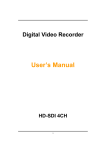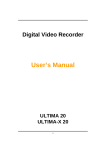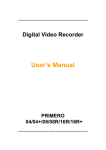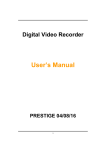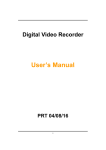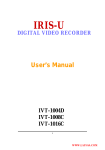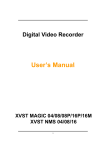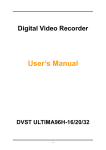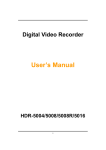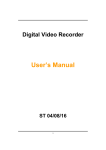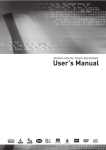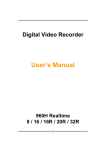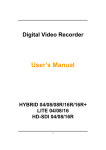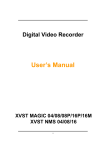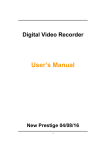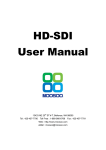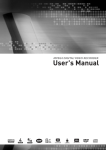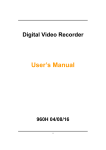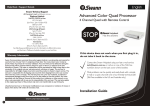Download User`s Manual User s Manual
Transcript
Digital Video Recorder User’s User s Manual PRIMERO 4 1 Thank you for using our product. 1. This is user's manual for H.264 HD DVR (Digital Video Recorder). 2. This manual contains product specification and introduction, installation guide, operating guide and other necessary matters for easy understanding. Users should read this user's manual carefully for proper use. 3. Contents in this manual may be changed according to the specification change and f t feature improvement i t without ith t any notification. tifi ti 4. This user's manual shall never be copied without prior agreement and violating this may be a reason for legal punishment on piracy. 5. If there is any incorrect or insufficient content in this user's manual, notify it to Customer Support Center. 2 CONTENTS Contents CH 1. Product Introduction 1-1. Product Contents 1-2. Specifications 1-3. Product Characteristics 1-4. Name of Each Part 5 6 7 9 CH 2. Installation Guide and Cautions 2-1. Cautions 2-2. Product Installation 2-2-1. Power Connection 2 2 2 Connecting External Device 2-2-2. 11 14 14 14 CH 3. How to Use 3-1. General Usage Information 17 3-2. Live Mode 3 2 1 Live 3-2-1. Li mode d control t l 3-2-2. Live mode feature 18 18 20 3-3. Search Mode 3-3-1. Search selection type 3-3-2. Play mode 25 25 29 3-4. Setup Mode 3-4 3-4-1. Display 3-4-2. Record 3-4-3. Device 3-4-4. Network 3-4-5. System 30 30 32 37 43 46 3-5. 3 5. Firmware Upgrade 49 3 CONTENTS Contents Trouble Shooting 51 Warranty 52 Appendix pp A How to Connect Receiver 53 Appendix B Catcheye for Android mobile 55 Appendix C Catcheye for iPhone 61 Appendix D How to Connect POS 68 4 CH 1 Product Introduction CH1. Product Introduction 1-1. Product Contents After removing packing materials of this product, check whether all following contents are included. Main Body (DVR): This converts the analog video and audio signal to the digital signal and saves on HDD. Adapter: p supplies pp ppower to the pproduct. This 12V adapter Power Cable: This connect the adapter and the power source. g CD: Program This contains the User’s manual and Client Program for DVR. Remote Controller: This is an IR remote controller for convenience. Battery: These are 2(two) battery for the remote controller. 5 CH 1 Product Introduction 1-2. Specifications Video Input : 720p, 1080i, 1080p Recording Speed : 720p :1~120fps total 1080p : 1~60fps total Compression Method : H.264 Technology Power : DC12V, 4.16A (DC adapter) Power Consumption : 50W External Terminal : Video Input - BNC 4CH Video Output - SPOT 1CH, VGA 1CH, HD output 1CH Audio Input - RCA 4CH Audio Output - RCA 1CH Sensor Input - Terminal Block 4CH (NO/NC selectable) Sensor Output - Terminal Block 1CH (Dry Contact) LAN Communication - RJ45 Port Serial Communication - Terminal Block(RS485) 2xUSB 2.0 Type A Video and control Transmission - RJ45 Port using xbox I Temperature : 5~40℃(30~110 F) Humidity : 20%~80%(Non-condensing) Size : 340 (W) × 250 (D) × 60 (H) mm Weight : 3Kg(Supplements and Packing Materials Excluded) Supplements : Adapter 1 Power Cable 1 Program CD 1 Remote Controller 1 Battery 2 6 CH 1 Product Introduction 1-3. Product Characteristics 1)) HD Video This DVR can record HD and Full HD video with extreme quality. Also it displays real HD(1920X1080) resolution, and therefore it provides the most clear image quality and the best security level. 2) High reliability With Embedded hardware and software design, this maintains higher product reliability. 3) Simple usage This allows users to use it conveniently by placing control buttons similar to existing ones on VCR, and users can easily learn the usage. 4) Pentaplex System Pentaplex System allows live, recording, backup, networking and playback simultaneously. 5) Selectable recording setup For recording methods, users can select the frame rate, resolution and video quality individually in order to be appropriate for user's environment. 6) Remote monitoring With using exclusive line or Internet network, you can search or monitor recorded images remotely by installing exclusive client program on Windows PC or Mac. 7) Backup You can backup with a versitile external USB devices. 8) Audio recording You can record 4 sound inputs simultaneously. Moreover, you can listen to the sound in search and live monitoring and play mode. 9) Various V i recording di methods th d This provides convenient use with manual recording, recording by dates and days, hourly schedule recording, sensor and motion detection event recording and others to enable unmanned monitoring. 10) Various total monitoring features You can cover any security scenario through various sensor inputs and contact output control. 7 CH 1 Product Introduction 11) Display information in easy-to-understand information method Thi enhanced This h d convenience i off user bby di displaying l i iinformation f ti (date, (d t time, ti recording di method, recording frame number, HDD capacity and others) in monitoring, recording and playing mode in easy-to-understand way. 12) P/T/Z control By built in RS485, various P/T/Z cameras can be used. 13) Dual CODEC for video transmission DVR can send d 120 fps f (based (b d on CIF)) regardless dl off the h local l l recording di andd viewing i i setup regardless with recording setup. 14) Web browser support You can monitor and playback the video and control the PTZ camera by internet explorer. 15) Built in S.M.A.R.T. You can automatically check the health of the hard disk drives. 16) Language pack Basically DVR has multiple language set, furthermore you can choose the language set if you want. 17) Mirroring by internal HDD If you install two HDDs, you can use the second HDD for backup for maximum fault tolerance. 18) Spot monitoring Spot out can be enable to monitor sequentially in other place. 19) Touch LED Switch You can operate with touch LED switch in front panel. 20) Text inserter(POS Interface) You can operate with the POS and ATM. 8 CH 1 Product Introduction 1-4. Name of Each Part [Front Panel] 5. NUMBER SELECTION 2. USB 4. CONTROL WINDOW 1. IR WINDOW 3. STATUS RAMPS 1. IR Window : the window for remote controller 2 USB ports : These USB ports are for mouse and USB devices 2. devices. You should connect correctly the USB devices and mouse as picture directed. 3. Status lamps POWER : Blue color back light. Power indicator. RECORD : Red. Indicate the recording. NETWORK : Green. Lit on connecting the network 4. CONTROL WINDOW : Going to Menu and Backup Video, Search Video 5. Number Selection : Use for Channel Selection and Number input in Setup Menu 9 CH 1 Product Introduction [Rear Panel] 9.SENSOR IN 10. AUDIO IN 11.AUDIO 8.RELAY OUT 7.RS485 13.Xbox Extender (option) 1.FAN 3. LAN 12.HDMI 4.SPOT 5. VGA 6. POWER 2.VIDEO IN 1. Cooling Fan 2. Video In: This receives images from SDI cameras. 3. LAN Port: This is the Gigabit Ethernet LAN cable connection terminal. 4. SPOT Out : To CRT 4:3 monitor for spot video. 5. VGA port: video output for analog RGB display 6. DC Power : DC12V 4.16A or up 7. RS485 port : For control the pan and tile cameras. Make sure that the polarity. 8. Relay out : This terminal blocks connect external electric devices to the product ( Warning Lamp and others). 9. Sensor In : This terminals can be connected to external sensors. 10. Audio In: RCA audio in terminals. You can record four channels at the same time. 11. Audio Out: RCA audio out terminal. 12. HDMI : HDMI output for HD monitor 13. Xbox Extender (option) : Connect to xbox for VGA and USB extention with FTP cable (Refer to Appendix A) ※ For more details, refer to [CH 2. Installation Method and Cautions]. 10 CH 2 Installation Method and Cautions CH2. Installation Method and Cautions 2-1. Cautions WARNING Risk of electric shock. Do not open the cover of the product. Servicing of this product by unauthorized personnel is prohibited and will result in a void of warranty. In order to ensure the most stable conditions for power, the use of a UPS (Uninterrupted Power Supply) is recommended. - Avoid installing the product where there are direct rays or it is hot by locating near from heat generator. (May cause fire) - Do not put vase, flowerpot, cup, cosmetics, drug, and anything the contain water on product. (May cause fire or electric shock, and it may injure people by falling) - Do not insert or drop any metal object (coin, hair pin) or flammable object (match, paper) into air hole. (May cause fire or electric shock) - Do not put any heavy object on it. (May injure people by being fell or destroyed.) - Put power plug surely not to be moved. (If not, this may cause fire.) - Unplug power plug and antenna when there are thunders and lightening. (May cause fire.) - For cleaning the product, wipe surface with dry towel. Using chemical agent or cleaner may change the color and unpeel paint. Do not put several plugs at same time. (May cause electric shock.) If there is smoke or strange smell, stop operation. In this case, turn the power off and unplug it, and then contact our service center. (If you keep using it, this may cause fire or electric shock.) - Do not unplug by pulling cord. (If cord is damaged, it may cause fire or electric shock ) shock.) - Do not plug or unplug with wet hands. (May cause electric shock.) 11 CH 2 Installation Method and Cautions - Keep the power cord untwisted. (May cause fire or electric shock.) - Use proper adapter. (Using too much electric power may cause fire or electric shock.) - Do not install it at where exposed to rain and wind and water drop. (May cause fire, electric shock and transformation.) - Keep away from fire. (May cause fire.) -Do not disassemble or remodel on your own. (May cause malfunction or electric shock.) - Do not put next to flammable materials like flammable spray. (May cause fire.) - Do not install it at a place with too much dirt. (May cause fire.) - Do not install it on unstable places like shaking table and inclined place or shaking place. (May injure users by falling down or being upside down.) - Do not put an heavy object on power cord or avoid it from being pressed by the device. (May cause fire or electric shock.) - In case of using extension cord, do not use several devices at same time. (May fire with abnormal heating of extension.) cause - When there are dirt on power plug pin or power outlet, clean it nicely. (May cause fire.) -Do not damage on power cord or plug, and bend or twist or pull too much, and put it between other objects or heat. If power outlet insertion part is not tight, do not use it. (May cause fire or electric shock.) -Do not drop or give a shock to the product. (May injure people or cause malfunction.) - Do not touch power adaptor or signal controller. (May cause electric shock.) - Do not put any object too close to block cooling fan. (May cause fire.) - In case of exchanging batteries with improper type, there might be danger of explosion. - For used batteries, throw away separately from other garbage. - When you take out batteries, avoid children from eating them by mistake. Keep them away from children. (If a child ate them, contact a doctor right away.) 12 CH 2 Installation Method and Cautions Note : This equipment has been tested and found to comply with the limits for a Class A digital device device, pursuant to part 15 of the FCC Rules. Rules These limits are designed to provide reasonable protection against harmful interference when the equipment is operated in a commercial environment. This equipment generates, uses and can radiate radio frequency energy and, if not installed and used in accordance with the instruction manual, may cause harmful interference to radio communications. Operation of this equipment in a residential area is likely to cause harmful interference in which case the user will be required to correct the interference at his own expense. Changes or modifications to this equipment may cause harmful interference unless the modifications are expressly approved in the instruction manual. The user could lose the authority to operate this equipment if an unauthorized change or modification is made. This device complies with the part 15 of the FCC Rules. Operation is subject to the following two conditions : (1) this device may not cause harmful interference, and (2) this device must accept any interference received, including interference that may cause undesired operations. FCC Warning : This equipment may generate or use radio frequency energy. Changes or modifications to this equipment may cause harmful interference unless the modifications are expressly approved in the instruction manual. The user could lose the authority to operate this equipment if an unauthorized change or modification is made. CE Warning : This is a Class A product. In a domestic environment this may cause radio interference in which case the user mayy be required q to take adequate q measures. This product has obtained EMI registration. 13 CH 2 Installation Method and Cautions 2-2 Product Installation Thi product This d t may bbe composed d off camera and d monitor it iin default, d f lt andd additionally dditi ll the sensor, microphone, speaker and PC for network can be connected if necessary. 2-2-1. Power Connection 1) Connect adapter cable to power connection terminal at rear side. 2) Input AC power to the adapter. (free voltage from 100V to 240V, 50/60Hz) ※ You must operate it at the rated voltage instructed on the user's manual. In case power higher hi h than h the h rated d voltage l iis supplied, li d it i may cause damages d on product. d 2-2-2. Connecting External Device ※ Connect it when power of the product is off. ※ Read through user's manual for the device you are connecting carefully. 1) How to Connect External Video/Audio Device MIC CAMERA Connect cameras to VIDEO IN by channels. Connect microphone (AMP) to AUDIO IN by channels. Connect VIDEO OUT to VIDEO IN of monitor. Connect HD output to HD Monitor. Connect AUDIO OUT to AUDIO IN of monitor (or speaker). Connect Spot output to Composite Monitor. 14 CH 2 Installation Method and Cautions 2) How to connect external sensor Sensor terminal is composed of 1 input channel and 1 output channel. Sensor out terminal is relay output with 1A, 1A 24V or 0.5A,125V. 0 5A 125V SIREN SENSOR - + POWER Sensor In : Connect the sensors. The sensor are composed of both signal and ground terminals, with a voltage difference of 5V. In the case that the sensor used for input is of the N/O (Normal Open) type, when the voltage difference between the signal and ground falls to 0V (short), the DVR can use this as a trigger to start alarm/sensor b d recording. based di Sensor Out : Connecting external electrical devices The relay output terminal does not provide power, and functions only on an ON/OFF basis via a relay. Normally, the signal and ground should be on an OPEN basis, and the DVR will complete the relay connection. 3) Connecting with PC using LAN cable If you want to connect DVR to PC directly, use LAN cable, and if you want to use HUB, connect cable via hub. *Hub : This is a device connecting one office to devices located near with using cable when you organize LAN *Cable : This is standard UTP cable used for communication among devices through Hub and others when you organize LAN PC HUB 15 CH 2 Installation Method and Cautions 4) Connection Using PTZ camera In case of using pan and tilt cameras, connect PAN/TILT DRIVE to product as shown h att following f ll i figure. fi VIDEO CABLE SPEED DOME RS485 CABLE 5) Installing Hard disk drive In case of installing the hard disk drive, drive open the upper case and install the hard disk drive on the hard bracket. Remember that the main power should be off to install the hard disk drive. If you have any trouble, please contact the technical support. 16 CH 3 How to Use CH3. How to Use 3-1. General Usage Information The ULTIMA series DVR can be operated with a mouse or remote controller under the four main modes listed below: Live Mode – This is the “main or default” mode. From this mode you can view in real time all currently operating cameras, information regarding camera status, and have access to Pan/Tilt camera controls. In addition, system status information will b shown be h dduring i live li mode, d andd other th modes d can be b entered t d from f Live Li mode. d Setup Mode – The user will be able to customize settings for Live viewing, Recording, Backup, and Camera related devices under the Setup Mode. Search Mode – In Search Mode, the user will be able to review all recorded footage in the case that an event must be reviewed using a calendar or event based search. Backup Mode – In Backup k Mode, d the h user will ill be b able bl to archive hi the h desired d i d data d to the preferred supported media of their choice (ex. CD, DVD, USB Backup, Remote Client Software, etc.) Password Protection – The DVR system will utilize a user ID and password system to prevent unauthorized usage of this product. Control of the system will only be possible after entering a proper ID and password as illustrated below. (Factory Default settings are blank for these fields). IDs and passwords should be managed by a system administrator, as different users may be given different levels of access to the DVR. 17 CH 3 How to Use 3-2. LIVE Mode IIn this hi section i you will ill know k how h to split li the h video id mode d into i 1, 1 4, 4 6, 6 8, 8 9, 9 12, 12 16, 16 as well as auto sequencing, PTZ Control, Mouse control, Setup configurations, Backup 3-2-1. LIVE Mode Control 1) Live View Status You may use the Live Menu Bar located at the bottom for quick shortcuts and view status of certain items. Recording indicator Event recording di indicator i di Motion detection indicator Sensor activation indicator POS indicator 2) Live Menu Bar You may use the Live Menu Bar located at the bottom for quick shortcuts and view status of certain items. 18 CH 3 How to Use Date Time Screen Split mode change Sequence activation Hard drive usage Lock/ Unlock indicator Scheduler activation indicator Audio out channel indicator Mute indicator 3) Live Popup Menu By Right-Clicking anywhere on Live Screen, you may view the Live Popup Menu. By using the Live Popup Menu, you can quickly jump to the necessary configuration and settings. 19 CH 3 How to Use 3-2-2. LIVE Mode Feature 1) Setup : refer to 3-4 2) Split Change video split mode for Live View. 4ch : 1/4 Split Mode 3) Audio Out You can choose the audio out from this menu. 4) Instant Replay This is very convenient function to catch the abrupt accident. During live viewing, you can go directly to the playback screen. If you choose the ‘Instant Replay’ , the DVR goes to the ‘PLAY’ with the present time screen. And you can use the functions related playback. 5) Search : refer to 3-3 20 CH 3 How to Use 6) Backup Th are two There t ways to t enter t the th backup. b k The Th first fi t one is i that th t right i ht click li k on the th live li screen, and the second one is that enter directly from ‘Search’ upon playback. If you choose the ‘backup’ from the live menu, below backup screen appears. • You can set the backup device, time and channel from the backup screen. • After that, if you push the ‘Estimation’ button, it will show the estimated backup file size. • Then click the ‘Start’ button. WARNING Do NOT remove the backup device till end sign. The device and system may be damaged. 21 CH 3 How to Use 7) Snapshot You can save the live snapshot by this menu. All channel will be saved individually to the USB memory by JPG format . You should put in USB memory before saving. 8) PTZ (Pan, Tilt and Zoom) It is possible to control the pan and tilt camera by itself. Press the ‘PTZ’ button to enter the PTZ mode. For Menu setting, you can set it by pressing button as displayed at bottom of window. • You can set the direction of camera by using the arrow buttons. • Setup : If you press Setup using mouse (or Menu button on the remote controller) in PTZ Menu, PTZ setup window will appear. You can set the pan and tilt speed, 32 preset name and tour sequence as well as dwelling time, • Zoom In/Out : You can zoom in/out with mouse or play /backward buttons on the remote controller. • Focus In/Out : You can adjust the focus with mouse or slow buttons on the remote controller. • Iris In/Out : You can adjust the iris with mouse or ff/rew buttons on the remote controller. 22 CH 3 How to Use •Preset : You can enter the preset number using the keypad appearing the preset button or ‘Enter’ button on the remote controller. 9) Zoom Digital zoom of live screen for selected channel. It can be 2x zoom and also control the position by mouse dragging. 23 CH 3 How to Use 10) Sequence Sequence Mode On /Off: Switches screens as set on Dwell time under Screen Setup 11) OSD This feature shows current settings of product through GUI (Graphic User Interface) and INFO button at front side is used for this feature. When you turn on power, this will show current date and time, System Lock Setting, HDD usage, Video Loss Check, Sensor ON/OFF, Motion Detection Check, Recording Stat us and Schedule Feature Usage. As you press INFO button once more, GUI disappear->OSD disappear->GUI appear->OSD appear will happen sequentially. ※ GUI (Graphic User Interface): displaying current status on monitor as images ※ OSD (On Screen Display): displaying current status on monitor as character 12) Lock/Log In Logs off current user and locks DVR from any further configuration and screen setup until next Administrator logs in. 24 CH 3 How to Use 3-3. Search Mode Search mode consists of two different modes of searching. The video data can be selected by 5 modes. Time : Search by Month / Day / Time selection. Event : Select from Event Log POS : Search by POS transaction data Thumbnail : Play the specific channel by user defined interval Panorama : Play the specific channel continuously 3-3-1. Search Selection Type 1) Time Based search selection - Select the Date you wish to view by selecting a Date from Calendar - Select time you wish to view by selecting a time from Time Line - You may click on Refresh, Option, Backup, Import, Exit , Full Screen for additional features and options 25 CH 3 How to Use 2) Event Based Search Selection - Select search date from calendar - Event log will be displayed according to the chosen date pane above the Event Log g will show ppreview of currently y selected video - Preview p - You may click on Refresh, Option, Backup, Import, Exit, Full Screen for additional features and options 3) POS Search - Select search date from calendar - POS transaction data will be displayed according to the chosen date - You can search detail by filter. - You may click on Refresh, Option, Backup, Import, Exit, Full Screen for additional e u es andd options op o s features 26 CH 3 How to Use 4) Thumbnail Search - Select search date from calendar - Choose the channel and interval, then select the time from bar or typing played y individually y by y interval time difference - The selected channel will be p - You may click on Refresh, Option, Backup, Import, Exit, Full Screen for additional features and options 5) Panorama Search - Select search date from calendar - Choose the channel and time from bar or typing - The selected channel will be played continuously. If you want to play faster, use the FF button. - You may click on Refresh, Option, Backup, Import, Exit, Full Screen for additional features and options 27 CH 3 How to Use 6) Search Related buttons Reload all data list. Search option. Backup recorded data to external USB device. Pl b k recorded Playback d d data d t from f external t l USB device d i Move to Live video mode. Load playback data to full screen mode. 28 CH 3 How to Use 3-3-2. Play Mode If you choose ‘Full Screen’, the full screen appear. You can control the play speed in here. ▶ Play Screen GUI 1. Split Screen 2. Sequence q 3. FB (Fast Backward): FB×2, 4, 8, 16, 32, 64 times faster 4. Playback : Backward normal speed 5. SB (Slow Bacward):SBx1/2, SBx1/4 6. STILL (Pause) / Frame advance 7. SF (Slow Forward):SFx1/2, SFx1/4 8. Play : Forward normal speed 9. FF (Fast Forward): FF×2, 4, 8, 16, 32, 64 times faster 10. STOP : Stops playing and returns to LIVE Screen. 11. Status information 29 CH 3 How to Use 3-4. SETUP Mode Access S A Setup t menu ffrom Ri Right ht Cli Clicking ki mouse button b tt to t Popup P Menu. M Configure Display, Record, Device, Network, System which is navigated by clicking on corresponding tab menu at the top of the screen 3-4-1. Display Configure OSD, Main Display, Color Control setting. 1) OSD You may configure and/or view Date Format / Time Format / Language / Alpha Blending / OSD / Information Bar options Date Format: Select from YYYY/MM/DD, MM/DD/YYYY, DD/MM/YYYY Time Format: 24H – 24hour military time 12H (AM/PM) – 24 Hour separated by AM/PM Language : Select system language Alpha Blending: Adjust transparency of System Menus OSD : OSD On/Off Information Bar: Information Menu Bar Hide/Auto hide/ Show always Display HDD Usage : Percent/Oldest Date Default : Factory default all configuration values Apply : Save current page configuration 30 CH 3 How to Use 2) Display Configure and view VGA Resolution, Sequence Dwell Time and Display control settings. VGA resolution : You can choose the VGA Resolution from 1920X1080(60Hz), 1920X1080(50Hz), 1280X720(60Hz) and 1280X720(50Hz). Sequence dwell time : You can adjust the dwell time upon full screen switching. Display control : You can adjust the brightness, contrast, hue and saturation of output. 3) SPOT Control Set the SPOT output . You can set the SPOT output. - CVBS : Choose NTSC or PAL - Mode : Choose ‘Full’ or ‘Quad’. - Sequence dwell time: Adjust the switching time. - Switching : You can program the sequence time. If you want to just see ch1, you set all box to ‘1’. You can make any useful sequence by this map. 31 CH 3 How to Use 3-4-2. Record Configure and view Event In, Record, Group, Holiday settings 1) Record With this menu, you can set the recording variables of DVR and the Scheduler. 1) Rec type: to set continuously, event, C/E(conti and event) and none(not recording). 2) Audio Rec: to select audio recording or not. 3) Conti Recording: continuous recording mode setting. ① Resolution: You can choose 1920X1080 or 960X540 if you connect 1080p or i camera. You can choose 1280X720 or 640X360 if you connect 720p camera ② FPS: FPS Set S t recording di fframe rate. t 1,2,3,4,5,6,7,8,9,10,11,12,13,15,25,30,50,60 1 2 3 4 5 6 7 8 9 10 11 12 13 15 25 30 50 60 are possible You can check the total number of frames in ‘Total’. Maximum is 60frames@1920X1080 ③ Quality: Set picture quality. As quality gets higher, screen quality gets better but saving period gets shorter because file size gets bigger. There are 4 steps quality such as Super, High, Medium and Low To save the setting, choose ‘Apply’ after setting. 32 4) Event Recording This is a window setting Event Record Mode. Setting method is same as Conti Recording method. method Conti Recording and Event Recording can be operated simultaneously. So during no event input, DVR records by Conti recording settings. However if there is an event , it starts recording by Event Recording settings during Time(sec). This function is very useful when you want to operate with the mixture mode. - Duration(sec): to set post event recording time. You can choose between 1~59 seconds. seconds - Pre alarm(sec): to set pre event recording time. You can choose 1~4 seconds. 5) Estimated Recording Days : This is an automatic calculator of the recoding days. * Event recording has priority in recording. In C/E recording, the recording will f ll conti follow ti recording di setup t iin normall condition diti while hil it would ld follow f ll eventt recording setup in event generation. * For convenience, you can use the ‘Apply All’ menu to change with the same preference. You don’t have to setup each channel if you using the ‘Apply All’ function. [When Scheduler On] If you select Schedule , following [Schedule Recording] setting window appears. If you choose Schedule On, the weekly scheduler is activated. Since you can set recording weekly, you can reduce recording of unnecessary time period. In Scheduler window, days and channels are displayed, and recording information for each channel is displayed at bottom of window. <How to set the weekly scheduler> 1. Choose 'Scheduler' to 'On'. 2. Choose group and drag to wanted time. 3. Press the time bar if you want to set the detailed time. 4. Press ‘Enter' button to change the group of the selected area. 5. If you activate ‘Holiday’ scheduler, choose ‘holiday’. 33 CH 3 How to Use 2) Group With this menu, you can set the group using the scheduler. If you choose ‘Group’ tab, you can see the similar screen with ‘Record’. The setting is similar. *In recording, Schedule recording setting is most preferred. So if you activate the weekly scheduler, you cannot record manually. 34 CH 3 How to Use 3) Holiday With this menu, you can add the holidays. Use the ‘Add’ button for adding the holiday and use the ‘Delete’ or ‘Delete All’ buttons for removing the existing holidays. 35 CH 3 How to Use 4) Event In With this menu, you can set sensor input, motion detection setup. You can also set each channel individually. Each channel may be configured to M (Motion) / S (Sensor) / V (Both) * Summary regarding as Event Recording MD Motion Detection ON Sensor OFF ON MD/Sensor ON ON None ON ON Event Input MD recording di Sensor detection and recording MD,Sensor detection and Recording MD,Sensor Detection and nonrecording Sensor Setting OFF *In REC Menu, MD recording, Sensor detection recording, MD, Sensor detection recording and no recording are determined according to Event Input. *Although you set Motion Detection and Sensor Setting to On in Event menu, if Event Input in Rec Menu is set to None, it only detects and does not record. 36 CH 3 How to Use 3-4-3. Device Configure and view Camera, Private Zone, Audio, Motion Detection, Alarm Out, PTZ settings and Controller. 1) Camera You may configure and/or view camera video type and general camera configuration. •Signal Type : You can choose between Auto/1080p60/1080p50/1080p30/1080p25/ 1080i60/1080i50/720p60 /720p50/720p30/720p25 •Name: You can set the camera name. •Disable : Disable current camera. It is useful when the signal is bad. •Covert : Hide current camera from Live view but Record for future searching option 2)) Private Zone If you want to hide some part of the picture for privacy, you can choose the area by dragging the mouse. The selected area will be changed to mosaic screen. ① All Off : .No mosaic. ② Apply all : apply the setting to whole channel 37 CH 3 How to Use 3) Audio •Audio Out: Select which channel will be heard during Live View. 4) Motion Detection Change settings for Motion Grid selection and Sensitivity Level. You can set multiple area. ① Sensitivity.: 3 steps ② All On/Off : This will activate or deactivate the motion detection of the all area. ③ Apply all : apply the setting to whole channel 38 CH 3 How to Use 5) Alarm Out There are 4 types trigger such as sensor input, motion detection, POS and video loss. This setting is related that which trigger will be activate the action such as Relay, Popup, and Buzzer Alarm Out. Each type can have separate Duration value and also linked to selected camera. Sensor Type: Selectable option is N.O. (Normally Open) / N.C. (Normally Close) You can choose the action after sensor in between relay, buzzer sound, pop up and spot pop up . Also you can choose more than one action. You can choose the action after motion detection between relay, relay buzzer sound, sound pop up and spot pop up . Also you can choose more than one action. Furthermore you can set the preset position number by motion detection. If you push the ‘setup’ you can see the preset screen. 39 CH 3 How to Use You can assign the preset position individually by specific motion. You can choose the action after POS transaction or video loss between relay, y, buzzer sound, pop up and spot pop up . Also you can choose more than one action. Duration Time from 5 seconds to 60 seconds 40 CH 3 How to Use 6) PTZ Configure Pan/Tilt/Zoom camera for control via DVR System and Remote client Driver: Choose Driver to be suitable for PAN/TILT Camera manufacturer. You have to set Comport value according to the connected camera. There are more kinds of camera which can be supported. Please contact the tech support to want to know the other cameras cameras. Baudrate PELCO D type 9600~2400 PELCO P type 2400 PANASONIC 2400~19200 ORIENTAL 2400(Fixed) LPT-A100L 9600(Fixed) LG-SD110 2400~19200 * For connection of PAN/TILT Camera Receiver part, refer to user's manual of the related PAN/TILT Camera. 41 CH 3 How to Use 7) Controller setss thee ID oof remote e o e control. co o . If you have ve many y DVRs V s in thee ssamee pplace, ce, you Thiss se can control separately the DVR by different remote control ID. Use the ID setup and number key to set the ID of remote control on the remote controller. You may check the ID by pressing the remote control key. The ID should be the same between the DVR and remote control. And you can turn it on/off the key sound. 8) POS This sets the POS interface(text inserter) with the DVR and cash register. • Baudrate : Select the baudrate of POS • Start Word : Type the start word of transaction • End Word : Type the end word of transaction. Text will be embedded into the picture between start word and end word. • Ignore word : Type the word which you want ignore during text insertion. • Number of add line : This will determine the adding line after end word. word • Overlay Position : This will determine the text position. • Text Overlaying duration : This will determine how long display the text up to 100 seconds. 42 CH 3 How to Use 3-4-4. NETWORK C fi Configure andd view i Address, Add P Port, DDNS DDNS, E-mail, E il Control C l andd Status S settings i 1) Address Configure Network information for Remote client connection • DVR Name : Type the URL of DVR using virtual keyboard. • Type : It can be supported only Ethernet • DHCP (Dynamic Host Configuration Protocol) Set whether you want to use DHCP or not (On/Off) If you connect LAN after setting it to On, IP is allocated automatically. If you set it to Off, you have to input IP. DHCP is a protocol that allows managers to manage and allocate IP address centrally centrally. 2) Port There are 4 kinds of ports for the case such as watch, search, setup and web. You can individually set the port number of the DVR. The default is 8000. You can choose from 8000 to 9999. If you activate ‘uPNP (Universal plug and play)’ box, DVR connects the router automatically with these port number. You don’t have to setup the router. 43 CH 3 How to Use 3) DDNS This is the function to automatically change the IP of DVR to URL. This product supports the automatic DDNS service using manufacture’s internal server. Also you can choose Dyndns. 4) E-mail You can send the event with snapshot by email. Fill all the information correctly and push the ‘Email Test’. Also you can select each event individually by ‘Event Set’. 44 5) Control You can individually adjust the resolution and frame rates of video transmission within 15 frames based on 1920X1080. Or you can send 60 frames based on 1920X1080 if you activate ‘Use Record Stream’ and set the record to 60 frames total. However, you need enough bandwidth to use this function. ① Resolution : You can choose CIF or D1 ② FPS: You can adjust the frame rate. ③ Quality: Set picture quality 6) Status This shows the information how many connections and what is the action of each connection connection. ① Connected IP : This displays all the connected IP. ② Watch User: This displays how many connection for live viewing. ③ Search User: This displays how many connection for playback playback. ④ Setup User: This displays how many connection for DVR setting. 45 CH 3 How to Use 3-4-5. SYSTEM Configure and view system Date/Time, User Authority, Storage, System Log and Configuration settings 1) Date/Time •Time Zone: Choose the time zone of your site. If you using the NTP function, it must be set correctly to your zone. •Daylight Saving Time: It enables to adapt the day light saving time automatically. • Date/Time: This sets product time. Input time by pressing number buttons after moving cursor with direction buttons. Be careful to move to backward. The overlapped data will be deleted with warning message. • NTP (Network Time Protocol) Server: This function is to change the time of DVR automatically via network. Press the ‘Enter’ Enter button and using the virtual keyboard, type the address of NTP server. 2) User Authority This sets User authority individually. You can give to each users the authorities such as setup, search, backup, PTZ, network and camera control. 46 CH 3 How to Use 3) Storage •Display the information and usage of the hard disk drives. If you press the ‘Format’ button on each HDD, only that HDD will be formatted. •Total : Display all the HDD usage being used for the product. If you press the ‘Enter’ button on here, all the hard disk drives will be formatted. • HDD Overwrite : Determine whether you want to continue recording if there is no spare saving space at hard disk drives. •Mirroring : If you install two hard disk drives, you can set the second drive as a backup drive by mirroring mirroring. The mirrored disk size will be the same or greater than master HDD. • Auto Deletion : You can select the holding period of the data. If you choose ‘OFF’, the DVR keep the maximum data regarding the HDD capacity. •Alarm Check HDD : There is an alarm if there is no HDD or no format. It is useful • to check the HDD absence. 4) S.M.A.R.T (Self-Monitoring Analysis and Reporting Technology) This function lets you probe the hard disk drives and investigate the status of the drivers automatically. •Check day : Determine the date to perform the SMART. •Boot B t message : the th number b off message off showing h i the th errors •Check Time : Temperature check period •Limit : The upper tolerance of the hard disk drive temperature •Alarm out : You can choose Buzzer or Relay 47 CH 3 How to Use 5) System Log You may view all System administration log from Setup System System Log. Also you can export the system log and easily send it to technical support for trouble shooting. 6) Configuration Shown at the following screen, from Setup System Firmware, you may view the current firmware version as well as Upgrade the firmware and additionally, Export, Import, and Default DVR Configuration. 48 CH 5 Client Program 3-5. Firmware Upgrade After installing Aft i t lli the th client li t software, ft you can find fi d the th ‘NetDownloader ‘N tD l d Program’ P ’ in i the th window programs (Start -> programs -> DVR Client -> NetDownLoader) . Please execute this ‘Net Downloader Program’ to upgrade the firmware of the DVR. After typing the IP and password of the DVR, click the ‘Connect’ button. You can check the model name and the current version. If you can’t see the model name and current version, version you should check the network and try again. again 49 CH 5 Client Program When you connect the DVR, click the ‘open’ button on the ‘NetDownloader Program ’and select the update file and then press the ‘start’ button. You can see the b l download below d l d window i d on the th DVR screen. ☞ WARNING!!! D not turn off Do ff the h power during d i d download l d procedure. d If you power off manually, all memory will be deleted ! ※ After upgrading, DVR will reboot automatically. Before rebooting, do not operate manually ! 50 Trouble Shooting Trouble Shooting S Symptom C Checkpoint C Countermeasure ● Can't turn on power ● Is DVR connected to power supply cable? ● Connect power cable ● There is no image on monitor ● Are DVR and monitor turned on? ● Are cables of DVR connected?. ● Turn on power. ● Connect DVR cable. ● Only INFO OSD is on monitor and no image ● There is Video Loss message. ● Is camera turned on? ● Are cables of DVR and monitor connected? ● Is NTSC/PAL setting normal? ● Is connection between DVR and camera normal? ● Can't search with Client Program. ●Motion Detection doesn't work well ● Check whether NTSC/PAL setting is SETUP properly ● Check whether DVR and camera are connected properly ● Isn't another user using same IP? ● Use it after another use finishes using it. If another user is searching DVR remotely with same IP, you can not search. ● Isn't it too bright or too dark? ● Increase Motion Detection sensitivity. ● Install camera closer. ● Isn't camera installed too far away? . ● There are differences between Live screen and actual condition during remote monitoring ● Live doesn't work well in remote monitoring ● Turn on camera. ● Connect cables of DVR and monitor. ● Is it set to True Color? ● Are PC specifications and VGA Card specifications are appropriate? 51 ● Since it buffers Live images, there might be changes with actual condition. (1~2 sec) ● Refer to recommended Client PC specifications in 4-1 Installing Client Program? Warranty Warranty This product guarantees free repair based on guarantee regulations only if the malfunction is caused while customers were using it properly. Warranty Period Warranty period begins from the day this product is delivered to customer. Model Name Warranty Period From . . . To . . . (for year) Address : User Company : NAME : TEL : Address : Retailer Company : NAME : TEL : In case the malfunction is caused by one of following reasons, repair shall be provided as charged service. A) If cause for the malfunction is from external condition other than the product B) If malfunction is cased because user tried to reassemble the product C) If malfunction is caused by natural disasters such as fire, water disaster, thunder and others D) If malfunction is caused while transporting or moving the product after purchasing 1. All other refunds other than warranty repair for this product shall be based on actual cost. 2. Refund standard about product repair, exchange or repayment observe Regulations for Compensating Customers' Damage provided by the Economic Planning Board. p ppart pproviding g pperiod is for five yyears from the dayy the production p for this 3. Repair product stops. Address Tel Fax URL 52 Appendix A Appendix A How to Connect xbox I 1. Connect EXTEND FTP cable to Receiver (upto 350ft/100m). Refer to http://en.wikipedia.org/wiki/Twisted_pair about the FTP cable. Connect Monitor and Wired/Wireless Mouse to the Receiver FTP(Foiled Twisted Cable) Receiver 2. Because all the case has different cable length, you should adjust the GAIN and PHASE in Receiver to get a most proper VGA output. You can use the small cross screw driver for adjusting at the edge of Receiver. Gain and Phase adjustment 53 Appendix A 3.This is the whole diagram. 54 Appendix B Appendix B Catcheye for Android mobile The Catch Eye allows for you to monitor DVRs. It now supports Live mode. Playback mode will be added soon. It is easy and convenient to use. The functions of Catch Eye: • Live View • 1/4/16 division • Channel switching • Server management • PTZ control • Digital zooming • Snapshot The functions operated by Touch: • Single touch : switch channel, Pan/Tilt. • Multi touch : Digital-Zoom, PTZ Zoom-In/Out 1. Starting When you o la launch nch Catch Eye E e for the first time time, Yo You need to register new ne DVR servers ser ers in the screenshot (as) below. Tap the menu button and select the “Add“ to continue. 55 Appendix B 2. Server Management Enter the appropriate data of your DVR server. - Server Name : Name that you want to associate with the DVR server. - IP address : IP address(example : 192.168.1.110) or a DNS name(example : 12345.3r.global.com). - Server Port : Port number(watch port in DVR setup). - User Name : Username(default is "admin"). - Password : User password. - Server Type : Embedded DVR, HD DVR, PC DVR When you finish, tap the "Save" button. 56 Appendix B The "Edit“ button modifies the information of the selected DVR Server. 3. Live Viewing Tap the DVR server item and select the “Connect” in menu when you register DVR server. The app. will show “loading, Please wait” as below. ** Wait Until it receives DVR channel data, it will take a few seconds depending on the network environment. 3G will take a longer time than WiFi. 57 Appendix B The next screen shows the first channel on DVR live view. “Channel", “Division“, “Save“, “PTZ” or “Zoom“ buttons are shown in menu. 4. Multi Channel Viewing - "Channel“, “Division” button If you select these buttons, sliding view will appear in live view so that you can change the channel or division that you want. Max channel depends on server’s se ve s max channel, c e , andd division d v s o type ype iss 1,4 , andd 166 division d v s o mode.(16 ode.( 6 division mode works on products support over 16channels. 58 Appendix B 5. Image Saving - "Save" button "S " bbutton captures current iimage. If you capture an iimage bby tapping "Save" i "Save" button, you can find the image file in your phone’s Gallery menu. 6. PTZ Control Mode - "PTZ" button The "PTZ" button allows you to control PTZ camera If the camera type of the channel is PTZ, the fourth button on the bottom bar will be named "PTZ". "PTZ" Otherwise, Otherwise “Zoom“. “Zoom“ Every PTZ function is controlled by touch. You can also control zoom-in, zoom-out, focus-in, focus-out functions by tapping menu buttons. If you tap the “Exit” button in “PTZ” mode or “Zoom” mode, channel mode will be changed to Channel-switching mode. There you can change channel by touch –to-scroll in the left or right direction. - Pan/Tilt Pan/Tilt functions are controlled by a single touch directionally. The app. will show the arrow on the screen as below. 59 Appendix B - Zoom-In/Out The Zoom-in/out function is controlled by multi touch from inside to outside or from outside to inside. The app. will show “+” icon in Zoom-in mode or a“-” icon in Zoom-Out mode on the screen as below. 7. Digital-Zoom Mode If the camera type is not pan-tilt, you can control the Digital zoom function. supported functions are as below. - Digital Zoom-in - Digital Zoom-out Every Digital Zoom function is controlled by your touch. Digital Zoom-in function is controlled by multi touch from inside to outside. Digital Zoom-out function is controlled by multi-touch from outside to inside. 60 Appendix C Appendix C Catcheye for iPhone The Catch Eye allows for you to monitor DVRs. It now supports Live mode. Playback mode will be added soon. It is easy and convenient to use. The functions of Catch Eye: • Live View • 1/4/16 division • Channel switching • Server management • PTZ control • Digital zooming • Snapshot The functions operated by Touch: • Single touch : switch channel, Pan/Tilt. • Multi touch : Digital-Zoom, PTZ Zoom-In/Out 1. Starting When you o la launch nch the Catch Eye E e for the first time time, Yo You needs to register ne new DVR servers ser ers in the screenshot as below. Tap the “Add server“ button to continue. 61 Appendix C 2. Server Management Enter the appropriate data of your DVR server. - Title : Name that you want to associate with the DVR server. - IP address : IP address(example : 192.168.1.110) or a DNS name(example : 12345.3r.global.com). - Port : Port number(watch port in DVR setup). - Username : Username(default is "admin"). - Password : User password. - Server Type : Embedded DVR, HD DVR, PC DVR When you finish, tap the "Save" button. 62 Appendix C The "Edit“ button modifies the information of the selected DVR Server. 3. Live Viewing Go ahead and tap the DVR server item in Addressbook table when you register DVR server. The app. will show “loading circle icon” as below. ** Until it received DVR channel data, it takes a few seconds(it depends on network environment. 3G will be longer than Wi-Fi) 63 Appendix C The next screen shows DVR live view for first channel. "CH", "Save" and “Digital-Zoom" or "PTZ“ buttons are shown in the bottom bar. 4. Multi Channel Viewing - "CH" button If you tap this button, sliding view will appear in live view and you can change channel and division mode. Max channel depends on server’s max channel, h l andd division di i i type is i 1 channel, h l 4 channel h l andd 16 channel h l mode. d Iff you finish change channel or division, tap "CH" button in bottom bar again. 64 Appendix C 5. Image Saving - "Save" button "S " bbutton capture 1 channel "Save" h l iimage. If you capture iimage by b tapping i "Save" button, you can find image file in iPhone's photo album menu. 6. PTZ Control Mode - "PTZ" button "PTZ" button makes you can control PTZ camera If camera type off the h channel h l is i PTZ, PTZ the h third hi d button b in i the h bottom b bar b will ill be b named "PTZ". Otherwise, “Zoom“. Every PTZ functions are controlled by your touch. You can also control zoom-in, zoom-out, focus-in, focus-out functions by tapping buttons. If you tap the “Exit” button in “PTZ” mode or “Zoom” mode, channel mode will be changed to Channel-switching mode. And you can change channel by touch and scroll left or right direction. - Pan/Tilt Pan/Tilt functions are controlled by single touch directionally. The app. will show the arrow in the screen as below. 65 Appendix C - Zoom-In/Out Zoom-in/out function is controlled by multi touch from inside to outside or from outside to inside. The app. will show “+” icon in Zoom-in or “-” icon in Zoom-Out in the screen as below. 7 Di 7. Digital-Zoom i lZ Mode M d If camera type is not pan-tilt, you can control digital zoom function. supported functions are like below. - Digital Zoom-in - Digital Zoom-out Every Digital Zoom function is controlled by your touch. Digital Zoom-in function is controlled by multi touch from inside to outside. Digital Zoom-out function is controlled by multi touch from outside to inside. You can also control Digital zoom-in and Digital zoom-out functions by tapping “ “ and “ " buttons. 66 Appendix D 8. DVR Information If you tap the "i“ button in top bar, you can see the DVR server’s information. DVR server Information list : - Server name - Server IP address - Channel name p - Server network timestamp - Image size 67 Appendix D Appendix D How to Connect POS 1. Connect the USB between POS and DVR. 2. Set the preference of the POS on the DVR. If your POS is in the device list in the text in setup of DVR, DVR you just simply choose that device. device If not, not you should choose ‘USER’ and manually set the values from the client software 68 Appendix D 3. To set manually, at first you should know the setting values of the POS. You can get the information from the POS setting screen. 4. If your setting is correct, you can see the below DVR screen on transaction. (This is the popup screen. You can set popup in the ‘Event In’ setup.) 69





































































